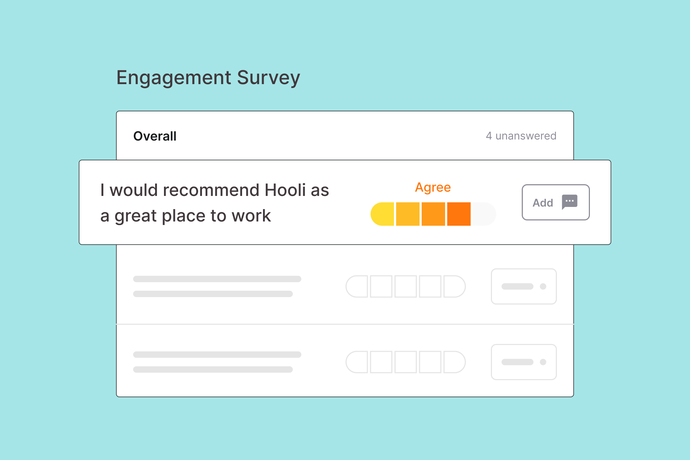5 ways to respond quickly to employee survey results

One of our customers recently said, “The worst thing we could do is conduct a survey and then do nothing.” And it's true – one of the biggest challenges that organizations face when conducting employee surveys is responding to them. Yet, it's mission-critical to not only effectively take action but to properly communicate your process for taking action and driving change.
However, a standard mistake organizations make is trying to do too much. They get results, identify ten areas for improvement, and then spend months fleshing out a strategy for how they will implement change.
All the while, employees wonder: “What happened with that survey we took?” With no awareness or visibility into the process, employees often assume nothing is being done.
Instead of spending a year strategizing on how you’re going to respond to survey results, learn from the success of agile HR teams and take small, iterative actions. These actions will result in incremental change so that employees can see results promptly. Then, you can gather more feedback and make more improvements over time.
In the spirit of tackling iterative action, here are five ways to respond quickly to employee survey results.
How to respond to employee survey results quickly
To ensure that employees feel like their feedback is being taken seriously, try out these five tips for taking action quickly.
1. Be transparent
Engagement issues often stem from a lack of communication. Either your employees don’t feel they are being heard or recognized, or there simply isn’t enough alignment within the organization regarding vision and values. Take your engagement survey as an opportunity to be transparent. Proactively share the results at your next all-hands meeting, and be honest about where there are areas for improvement. Share thoughts on how you’re going to make changes. Employees want to see that their leadership team is aware and on board to make change happen – that you're all in it together.
2. Dig deeper into survey results
Following up on engagement surveys doesn't have to be a massive undertaking. Once you’ve reviewed the initial results, dig a little deeper, if necessary. Maybe the responses to certain questions were not what you expected, or maybe you should consider rephrasing certain questions.
Consider sending them a follow-up survey if you notice something odd with one specific group. It doesn’t have to be a long survey – even asking 2-3 additional questions could do the trick. Another way to dig deeper might be to set up one-on-one interviews with groups that scored extra high or extra low on engagement and get additional qualitative feedback on why that might be.
It might also be worth conducting pulse and deep-dive surveys.
3. Review results with managers
1-on-1 meetings can be an excellent opportunity to understand how each manager is doing with their group. Encourage managers to set aside time during their weekly 1-on-1s to review survey results with their team.
Sometimes, engagement is linked to an employee’s relationship with their direct supervisor, as there is a link between leadership and employee retention. No one impacts your employees' day-to-day engagement and performance more than their manager. For that reason, managers are essential for addressing immediate and long-term engagement issues.
4. Host small group discussions
After conducting a survey, you often find there are geographic regions, departments, or certain demographic groups that offer the same type or level of feedback. However, the reason may still be unknown.
In such a situation, set up small group meetings where you can review the results with the group and host an open dialogue. Try to uncover why these groups may have a different experience than others. Sometimes it's something that can be easily remedied, but you may never really know without opening it up for discussion.
5. Organize an engagement task force
A good way to quickly show employees you're invested in taking action is to request their help. Depending on business objectives and survey results, determine which engagement issues need resolution and hold an open call for volunteers to join a task force. This will help you twofold – you’ll be working towards a resolution, and you’ll be engaging employees that are passionate about specific issues and empowering them to be the change they want to see.







